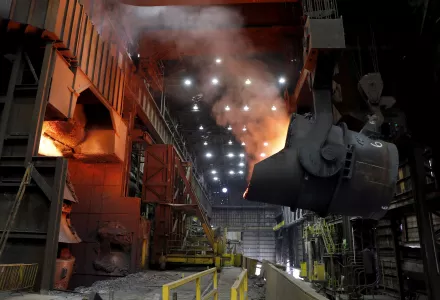
While hydrogen has been a staple in the energy and chemical industries for decades, green hydrogen from renewable energy sources is drawing attention as a versatile energy carrier with the potential to play a critical role in a carbon-free future.
The Environment and Natural Resources Program’s Future of Hydrogen project published several papers this year investigating renewable hydrogen production, use, and trade between countries.
In the following interview, ENRP Senior Fellow Nicola De Blasio and Research Fellow Laima Eicke share their insights on green hydrogen's growing economic and political momentum.
What makes green hydrogen such an attractive alternative energy vector?
NDB: Hydrogen is not a new commodity, but it never caught on for two reasons: in the early aughts, the focus was on mobility, and the cost of renewables was much higher. The latter circumstance has changed. In a world with growing penetration of renewables - and a grid not built to deal with the increasing intermittency associated with said renewables - the ability to store energy by producing hydrogen is a key value proposition. But to decarbonize, we have to use green hydrogen, produced by splitting water molecules using electricity from renewables.
LE: Many industrial sectors, like the chemical and steel sectors, use processes requiring very high temperatures that cannot be achieved through electrification. Green hydrogen offers a solution to these hard-to-abate sectors, which would otherwise be very challenging to decarbonize.
How have the war in Ukraine and the energy crisis in Europe changed the outlook for green hydrogen deployment?
LE: The war in Ukraine has highlighted Europe’s dependence on Russian natural gas, and it has put the need to look for alternatives back on the political agenda. Many European governments are now exploring different substitutes for Russian natural gas. Some have turned to liquified natural gas (LNG) from the United States, so clearly, not all countries are looking to green hydrogen as a short-term answer. But in Germany, all the new LNG terminals that are being built in response to this crisis must be designed so that they can be used to store and transport hydrogen in the future. So many countries see green hydrogen as a medium- or long-term solution to their dependency on Russian natural gas and their decarbonization goals.
NDB: Of the approximately 75 million tons of hydrogen produced annually, the vast majority isn’t green but is produced using fossil fuels. Green hydrogen is more expensive to produce – at least, it is if you don’t factor in the externalities of producing hydrogen from coal gasification or natural gas due to the associated carbon emissions. However, because of the war in Ukraine, the price of natural gas has skyrocketed in Europe, and the price difference has shrunk dramatically.
“The war in Ukraine has highlighted Europe’s dependence on Russian natural gas, and it has put the need to look for alternatives back on the political agenda.”
– Laima Eicke
How will green hydrogen deployment shape global energy geopolitics?
NDB: In our recent paper, "The Future of Green Hydrogen Value Chains," we examined how adopting green hydrogen at scale might affect energy value chains. In other words, should we expect to see hydrogen-producing countries exporting to countries with existing ammonia, methanol, and steel industries, or will these industries relocate closer to where hydrogen is produced?
LE: We looked at opportunities and risks that might emerge for different country groups in a green hydrogen economy.
We might see competition emerge between the “frontrunners” in the hydrogen race – countries with good resource endowment for green hydrogen production and existing industrial applications. The United States and China fall into this group, so this could be a new arena for competition between them in the future.
Countries with industrial demand for green hydrogen but not the domestic capacity to produce it – like Japan or Germany – will depend on imports. On the other hand, countries that lack existing industrial applications but have high green hydrogen production potential and generally good economic conditions could potentially attract some industries. So, we might expect competition for jobs and market share between these two country groups.
Another thing to watch is the dynamic between the Global North and Global South. For a lot of countries in the Global South, the green hydrogen economy represents the promise of sustainable development and green industrialization. But it’s an open question whether those countries will be able to move up the green hydrogen value chain or fall into a pattern of resource export dependency.
What are the most significant barriers to green hydrogen deployment?
NDB: As mentioned earlier, the cost of producing green hydrogen is a problem. It’s getting cheaper, but it needs to decrease even further. Infrastructure is another key barrier. Today, there’s basically no hydrogen infrastructure deployed at scale. Gas pipelines can carry a certain amount of hydrogen without needing any changes, similar to mixing ethanol into gasoline, to achieve a lower carbon intensity. But after certain percentages, they must be upgraded. That’s also assuming that the supply and demand centers for natural gas and hydrogen will the same, which isn’t true.
What is keeping you optimistic about green hydrogen?
LE: We’re seeing more and more countries develop hydrogen strategies. Hydrogen is on their political agendas. And there is a lot more international collaboration, too. It’s a step in the right direction, but success will depend on how those plans are implemented.
NDB: This is the first time in over a century that we’re discussing developing and deploying new energy systems at scale. The process will be long and expensive, and it will take extremely careful strategizing to avoid the mistakes and inefficiencies of the past. That said, as someone who has worked in energy all my life, it’s very exciting.
Hanlon, Elizabeth. “Two Views on Green Hydrogen: Possibilities and Challenges for a Carbon-Free Future.” Belfer Center Newsletter, Belfer Center for Science and International Affairs, Harvard Kennedy School. (Fall 2022)









